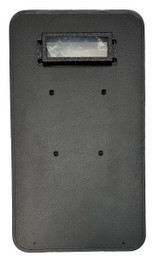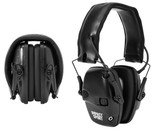Ballistic Shields Protection 101. Everything You Should Know, In One Place.
Ballistic Shields Protection 101. Everything You Should Know, In One Place.
Ballistic shields provide additional protection when you need it most and in situations when body armor cannot do its best. There are hundreds of potential uses for ballistic shields, so it is worth to take a closer look at how ballistic shields work, what kind of protection they deliver, and consider whether you need a ballistic shield in your work.
What is a ballistic shield, again?
Ballistic shields must not be confused with riot shields. While the latter are merely pieces of metal and/or polycarbonate providing zero ballistic protection and used mostly for crowd control, true tactical ballistic shields are protective devices that can stop bullets and projectiles and therefore save lives.
The materials ballistic shields are made from do vary, but today’s contemporary models are mostly composite, made from steel and high-tech polymers. Depending on your actual duties some materials may be preferable over others, but in general that does not play a significant role, because of the standardized NIJ protection ranking.
Types of ballistic shields
Here are the major types of ballistic shields available on the market:
- Small ballistic shields. Compact and lightweight, they provide protection to torso and head and allow for better mobility in comparison with standard-size shields.
- SWAT ballistic shields. These ones are your most useful protective devices. SWAT ballistic shields offer great protection and are equipped with a handle to hold the shield, a viewport or a window, and sometimes a flashlight. Better protection they give has a price: a wearer of the shield sacrifices some mobility.
- Ladder ballistic shields. This variation of ballistic shields has a ladder on the inner side, so such shields are extremely useful in dynamic entry scenarios.
- Ballistic blankets. Blankets are foldable large-area shields that can be used to defend civilians and allow officers to cover during surround or breach and hold operations. Typically, they offer only minimal protection, but that’s still a great deal and can save lives.
- Foldable ballistic shields. In the idle position, such ballistic shields are compact, so police officers can carry them around easily or just have them in a police car. Bodyguards can also use this type of quickly deployable ballistic shields.
- Ballistic rolling shield systems. These heavy-armored ballistic shields are put on a rolling platform. SWAT or police officer can cover behind this shield to slowly advance and clear the building during deliberate entry scenarios.
What are NIJ levels of protection?
The National Institute of Justice or NIJ is a federal organization that tests, classifies and develops safety standards that all manufacturers of protection gear must follow in order to get certified. The NIJ arranges ballistic shields across four categories or levels based on ballistic protection a shield provides.
Specifically, the following protection levels are considered a gold standard:
- NIJ Level II protection level means that a protective gear, a ballistic shield in our case, can withstand multiple shots from a handgun or a pistol armed with such rounds as 45 ACP, 9mm, .40 S&W, .357, etc. This is the lightest armor type among all levels of protection. Ballistic shields and blankets of this class are typically soft armor.
- NIJ Level IIIA offers better protection. A ballistic shield certified as this protection level can withstand almost any handgun rounds including, but not limited to .44 magnum or 9 mm.
- NIJ Level III is a hard armor developed to provide protection against rifle shots. Many SWAT ballistic shields are NIJ Level III.
- NIJ Level IV offers maximum protection against most ammo including those shot from rifles, shotguns, and even guaranteed to protect from high-speed bullets shot from sniper rifles.
It goes without explicit saying that better protection means higher weight and therefore less mobility of the wearer. Depending on actual situations and potential threats, police authorities may select different types of armor protection to achieve the optimal balance between agility and protection.
How to select ballistic shields
Ok, let’s make a peer review of factors you should consider when selecting a ballistic shield. Overall, you need to assess potential threats, and also should take into account who is going to wear the armor and in what practical situation.
Assess potential threats
Despite the name, a ballistic shield can deliver protection not only against ballistic threats, but also against other dangers. Potential threats include:
- Handguns. Lighter pistols and guns are extremely common on the streets and among criminals. If you expect some armed resistance, you should equip NIJ Level II or Level IIIa ballistic shields to your team. This could be smaller shields for a dynamic entry scenario, or typical shields if you plan deliberate entry instead.
- Rifles. Rifle shots are much more dangerous, because Level IIIA or below armor cannot reliably stop such bullets. If intelligence report the criminal is armed with a rifle or a shotgun, you may want to get the most from your heavier shields.
- Knives. Ballistic shields are effective against knife stabs too. Typically, even a small NIJ Level II shield is enough to stop the threat.
- Threats to civilians. If the situation involves civilians, foldable ballistic shields or blankets to protect them and let them out safely are a must.
Take into account who will be using the shield
Ballistic shields offer protection and safety, so many military, police, and security services uses them as standard. Typical examples include:
- SWAT officers. SWAT means “special weapons and tactics”. SWAT officers often rely on ballistic shield to protect their entry to the building or during surround and call operations.
- Police and law enforcement officers. Police also needs ballistic shields during assaults, or when performing their patrol duties in crime-ridden neighborhood where there’s high risk of gun fights.
- Security officersand guards are also in need of additional protection beyond that provided by body armor.
- Border patrol. These are niche users, of course, but still ballistic shields have some benefits for border patrols, mostly during special operations.
- Military can use ballistic shields and blankets as a part of their clearing missions or during combat.
- Corrections. Officers and guards serving in detention facilities can use shields when transporting arrested persons. However, most typically, correctional facilities use non-ballistic shields instead.
Typical SWAT scenarios and how to use ballistic shields in them
The success of a police operation depends on preliminary tactical planning. A commander should assess all risks, goals, potential threats, and all available intelligence on the criminals and the site. Then, one of tactical options is selected based on this analysis.
1. Takedown
This tactic basically means that a criminal is arrested outside, away from his or her home. Ballistic shields are rarely needed in this case unless the suspect is expected to be armed.
2. Ruse
Officers use some trickery or deception to force the suspect to leave the building. If executed carefully, this tactic also does not require using ballistic shields. However, if something goes wrong and the ruse does not work, protection may become necessary.
3. Surround and call out
Surrounding a building and calling the suspect out is a viable strategy when the tactical assessment tells there is a chance that the subject can surrender peacefully. Of course, hours may pass before this happens, so the police must hold the perimeter for a long time. And this is where ballistic shields or ballistic blankets provide extra coverage to law enforcement officers and nearby civilians, in addition to natural objects such as trees, vehicles, and walls.
4. Breach and hold
This tactics is for situations where holding the perimeter resolves into the need to breach an entry point and call out the criminal, or effect entry. The protection granted by ballistic shields is used as in the previous scenario, but also officers at the entry point might also need to be equipped with ballistic shields.
5. Dynamic entry
Dynamic entry is entry by force, when SWAT officers knock, announce, then immediately breach into the building and clear it as quickly as possible. While such surprise attack is potentially very dangerous, its high speed and overwhelming presence of law enforcement can be extremely effective in demoralizing suspects and put them down before anybody is hurt. Dynamic entry SWAT scenario relies greatly on use of lightweight ballistic shields. Such personal small shields offer protection from ballistic weapons as well as knives and even blunt weapons. At the same time, their compact size and low weight practically does not hinder the speed which is crucial for dynamic entry tactics.
6. Deliberate entry
Deliberate entry begins very similar to the dynamic entry: knock, announce, breach, clear the objective. The difference is in the way how this is done. Deliberate entry relies on slower pace, when every room in the building is cleared methodically, one by one.
Deliberate entry has its advantages and disadvantages over dynamic entries. For one, verbal commands allow for maximum efficiency of the clearing team, plus officers can command the suspects too forcing them out. The downside of the deliberate entry tactic is that occupants become informed about planned entry and can resist or even setup ambushes.
Apparently, deliberate entry requires much more protection. Hence, the use of SWAT ballistic shields, ballistic blankets, and rolling platforms is recommended. Additional accessories such as tactical flashlights mounted to shields can also help disorienting potential aggressors.
Of course, ballistic shields are mostly demanded in tactical scenarios 5 and 6. However, the range of uses of ballistic shields and blankets is truly limitless. Here are some more examples of how and when shields can be useful:
- Use ballistic shields to cover released hostages or walking-by civilians;
- Barricade the territory around the building using ballistic blankets in the surround and call out scenarios;
- Use small and light weight shields in dynamic entry scenarios to get maximum speed. And also grant protection when required: just crouch and keep the low profile;
- Use personal ballistic shields for efficient protection of other team members;
- Protect VIPs;
- Providing safe corridors to evacuate civilians;
- Using a ballistic shield with viewports for safe firing;
- Using a ballistic shield strobe light to disorient armed resistance;
- Using a ladder ballistic shield in dynamic entry to breach into the building;
- Barricading windows in a vehicle or in a building to protect those inside from projectiles and ricochets.
In conclusion
At BattleSteel®️, we know very well what a good ballistic shield should be. And we can help you select one that is ideal for your range of uses and tactics. In our online store we provide a wide choice of ballistic shields to select from. We have tested each one, and can guarantee excellent protection within the certified protection level.
If you have questions or need some assistance in choosing a proper ballistic shield for your particular situation, please don’t hesitate to contact us.
Recent Posts
-
Understanding Ballistic Shield Ratings and Their Applications
The Trusted Name in Tactical Defense - BattleSteel® When it comes to protecting those who protect us …2025-04-19 -
The Importance of Hearing Protection in Tactical Environments
The Legacy of BattleSteel® BattleSteel® is a trusted name in the world of tactical defense equipment …2025-04-14 -
How to Properly Fit and Wear a Plate Carrier
About BattleSteel and Their Mission BattleSteel is a trusted name in the tactical gear industry, ren …2025-04-11


